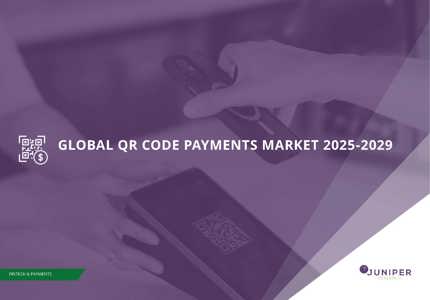QR Code Payments: Market Expansion and High-growth Areas
As we discuss in our latest research, QR payments have maintained strong usage in China since 2011; becoming the most popular form of contactless payment due to efforts from the likes of Alipay and WeChat Pay.
No other country has seen as long a history of QR codes for payments, but that does not mean QR code payments are not developing at a similar rate that China experienced last decade. Whilst a move to cashless societies has been a significant factor in enabling QR code payments readily, countries which have been making efforts to improve financial inclusivity for merchants and individuals alike have seen higher growth. As a result, the format of QR code payment implementation has varied between mature and developing markets.
Asia
Countries across Asia represent the greatest adopters of QR codes for payments outside of China.
India is leading this adoption outside of China, with major digital wallet and payment facilitators implementing QR code payment functionality since 2016. India established the UPI (Unified Payments Interface) to facilitate and process digital payments more efficiently in the country, and QR code payments being the most accessible digital payments created a sudden growth of popularity for the payment method which is still seen today. The UPI even has interoperability and international use through cross-border agreements with 25 countries in addition to the EU.
As a whole, Asia is the region with the most development of QR code payments globally. Asia Pacific countries like Indonesia, Singapore, Malaysia, and Thailand are some of the stronger QR code payment markets, but they are just several of the many that utilise the payment method widely. As a result of this, interoperability between these markets and their respective QR codes has been a focus, enabling cross-border transactions through QR codes within the region.
Latin America
Latin America represents the major QR code payment region outside of Asian regions, with individual markets adopting both national and third-party schemes.
Brazil is the largest QR code payment market in Latin America, made possible through the release of its Pix system for instant payments. Whilst third-party digital wallets operate in Brazil such as Mercado Pago, payments through Pix do not have transaction fees, encouraging many merchants and users to adopt the use of Pix QR codes for payments.
National schemes are not necessary for a sharp growth in QR code payment adoption, as seen from Argentina. Argentina used digital wallets like Mercado Pago and Bitso for QR code payments following the introduction of a renewed instant payments system in the country, and their widespread use encouraged the government to consider a degree of standardisation in the future.
Despite this level of success, not all countries in Latin America share that level of success. Mexico has a hybrid model for QR code payments between third parties and the Bank of Mexico’s CoDi. Launched in 2019, uptake of CoDi has been low, even among the digital wallet landscape, with cash still being the preferred POS payment method for many. This variance across Latin America highlights that successful adoption of QR codes for payments is not as simple as incorporating regulations or schemes from government-led initiatives.
North America & West Europe
Unlike high-growth markets, North America and West Europe have an established contactless payment user base utilising NFC technology.
As a result, QR codes are not used as a default payment method for many, but are acting as a vehicle into which payments can occur via digital wallets like Apple Pay. Therefore, QR codes are unlikely to ever replace cards and NFC as the preferred contactless payment method, but rather coexist.
Outliers to this trend exist however; Scandinavian markets like Denmark, Finland, and Norway break the mould of most QR code payment adopters due to having established card infrastructure in place and a high concentration of individuals with bank accounts. Trends like a shift to cashless societies still remains a factor, but the versatility and popularity of digital wallets remains a driving force for these countries in their adoption of QR code payments.
However, P2P-based QR code payments are popular among certain markets, like Payconiq in Belgium; enabling QR code transactions between bank accounts. This signifies that many are not wholly against QR codes for payments, and there is a possibility that they could be the preferred use in P2P payments.
Latest research, whitepapers & press releases
-
 ReportDecember 2025
ReportDecember 2025AI Agents for Customer Experience Platforms Market: 2025-2030
Our comprehensive AI Agents for Customer Experience Platforms research suite comprises detailed assessment of a market that is set to disrupt mobile communications. It provides stakeholders with insight into the key opportunities within the AI agents for customer experience platforms market over the next two years.
VIEW -
 ReportDecember 2025Fintech & Payments
ReportDecember 2025Fintech & PaymentseCommerce Fraud Prevention Market: 2025-2030
Our eCommerce Fraud Prevention research suite provides a detailed and insightful analysis of this evolving market; enabling stakeholders from financial institutions, law enforcement agencies, regulatory bodies and technology vendors to understand future growth, key trends, and the competitive environment.
VIEW -
 ReportNovember 2025Telecoms & Connectivity
ReportNovember 2025Telecoms & ConnectivityeSIMs & iSIMs Market: 2025-2030
Juniper Research’s eSIMs and iSIMs research suite offers insightful analysis of a market set to experience significant growth in the next five years. The research suite provides mobile network operators (MNOs), original equipment manufacturers (OEMs), and eSIM management and platforms vendors with intelligence on how to capitalise on the market growth, and guidance on how eSIM-only devices and sensors, SGP.42, in-factory provisioning, and iSIMs will change the competitive landscape.
VIEW -
 ReportNovember 2025Fintech & Payments
ReportNovember 2025Fintech & PaymentsModern Card Issuing Platforms Market: 2025-2030
Our Modern Card Issuing Platforms Market research suite provides a detailed and insightful analysis of this evolving market; enabling stakeholders from banks, financial institutions, fintech companies, and technology vendors to understand future growth, key trends, and the competitive environment.
VIEW -
 ReportNovember 2025Fintech & Payments
ReportNovember 2025Fintech & PaymentsDigital Wallets Market: 2025-2030
Our digital wallets research suite provides detailed analysis of this rapidly changing market; allowing digital wallet providers to gain an understanding of key payment trends and challenges, potential growth opportunities, and the competitive environment.
VIEW -
 ReportOctober 2025Fintech & Payments
ReportOctober 2025Fintech & PaymentsDigital Identity Market: 2025-2030
Juniper Research’s Digital Identity research suite provides a comprehensive and insightful analysis of this market; enabling stakeholders, including digital identity platform providers, digital identity verification providers, government agencies, banks, and many others, to understand future growth, key trends, and the competitive environment.
VIEW
-
 WhitepaperDecember 2025Telecoms & Connectivity
WhitepaperDecember 2025Telecoms & ConnectivityHuman + AI: Drivers of Customer Experience AI Agents in 2026
Our complimentary whitepaper, Human + AI: Drivers of Customer Experience AI Agents in 2026, examines the key drivers of the AI agents for customer experience platforms market in 2025.
VIEW -
 WhitepaperDecember 2025Fintech & Payments
WhitepaperDecember 2025Fintech & PaymentsBeyond Chargebacks: The True Cost of Fraud for Digital Commerce
Our complimentary whitepaper, Beyond Chargebacks: The True Cost of Fraud for Digital Commerce, examines the state of the eCommerce fraud prevention market; considering the impact of evolving digital fraud strategies, including key trends such as identity theft, account takeovers, chargebacks, policy abuse and friendly fraud.
VIEW -
 WhitepaperNovember 2025Telecoms & Connectivity
WhitepaperNovember 2025Telecoms & ConnectivityeSIM-only Devices: The Impact on Operators, Consumers, and IoT
Our complimentary whitepaper, eSIM-only Devices: The Impact on Operators, Consumers, and IoT, explores the challenges and opportunities for the three segments, with a particular focus on eSIM-only smartphones and SGP.42.
VIEW -
 WhitepaperNovember 2025Fintech & Payments
WhitepaperNovember 2025Fintech & PaymentsUnlocking the Next Stage of Growth for Modern Card Issuing Platforms
This free whitepaper analyses key trends shaping the modern card issuing space, and the ways in which modern card issuing platforms can capture growth.
VIEW -
 WhitepaperNovember 2025Fintech & Payments
WhitepaperNovember 2025Fintech & PaymentsTop 10 Fintech & Payments Trends 2026
Fintech is evolving fast. From stablecoins to agentic AI, our annual guide reveals the shifts redefining payments, digital identity, and the future of money in 2026. Download your copy today.
VIEW -
 WhitepaperNovember 2025Fintech & Payments
WhitepaperNovember 2025Fintech & PaymentsDigital Wallets: Empowering Financial Inclusivity
Our complimentary whitepaper, Digital Wallets: Empowering Financial Inclusivity, examines the state of the digital wallets market; considering the impact of digital wallets on different geographies, how they are shaping the modern payments landscape through lower transaction fees and promoting financial inclusivity for underbanked populations, and how they are competing with established payment methods.
VIEW
-
IoT & Emerging Technology
Juniper Research Unveils Top 10 Emerging Tech Trends to Watch in 2026
January 2026 -
Fintech & Payments
Digital Identity App Usage to Hit 6.2 Billion by 2030, Driven by Shift to Decentralised Models
December 2025 -
Telecoms & Connectivity
Travel eSIM Margins Under Pressure as Revenue per Gigabyte Falls 10% Globally in Two Years
December 2025 -
Telecoms & Connectivity
AI Agents to Power 1,000% More Customer Interactions for Enterprises Globally by 2027
December 2025 -
IoT & Emerging Technology
Global D2C Revenue Set for $370 Million Surge, But Satellite Operators Should Not Chase Full MNO Status
December 2025 -
Fintech & Payments
Digital Goods Fraud to Cost eCommerce Merchants $27 Billion Globally by 2030 as AI Tools Accelerate Attacks
December 2025





















